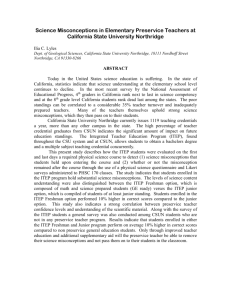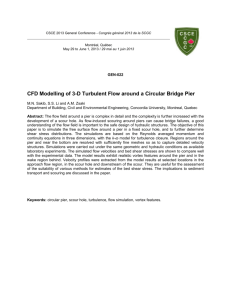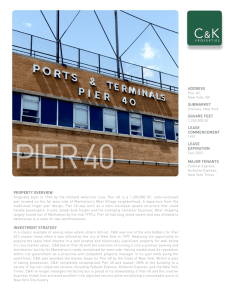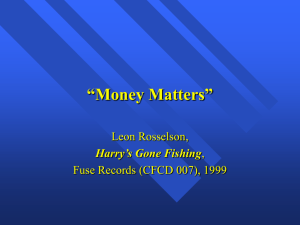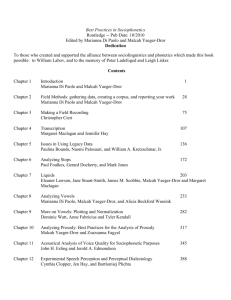Granieri_BIQ_workshop_16-9-2014_v3 - Indico
advertisement
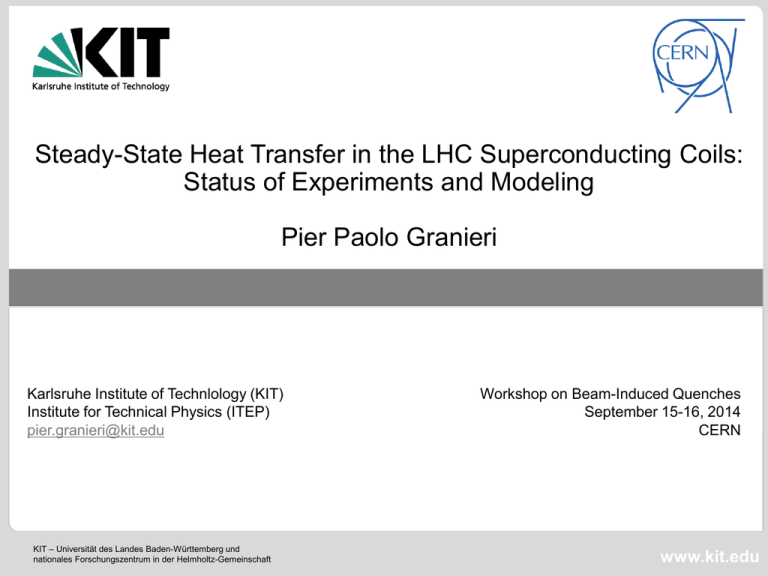
Steady-State Heat Transfer in the LHC Superconducting Coils: Status of Experiments and Modeling Pier Paolo Granieri Karlsruhe Institute of Technlology (KIT) Institute for Technical Physics (ITEP) pier.granieri@kit.edu KIT – Universität des Landes Baden-Württemberg und nationales Forschungszentrum in der Helmholtz-Gemeinschaft Workshop on Beam-Induced Quenches September 15-16, 2014 CERN www.kit.edu Acknowledgements D. Richter, D. Tommasini, P. Fessia, B. Baudouy, L. Bottura, L. Rossi, P. Lebrun, R. van Weelderen, D. Santandrea, T. Koettig, J. Bremer, L. Dufay-Chanat, D. Cochet, S. Prunet, J.-L. Carpano, M. Breschi, C. Meuris, B. Jeanneret, D. Leroy. N. Kimura, T. Nakamoto, A. Four, F. Lentijo, A. Mapelli, P. Petagna, J-B. Bureau, S. Luzieux, F. Beauvais, A. Bonasia, P. Jacquot, S. Clement, A. Benfkih, R. Bruce, B. Salvachua, S. Redaelli, L. Skordis, F. Cerutti, A. Lechner, M. Sapinski, B. Auchmann, A. Verweij, L. Esposito. B Colijn 2 16.09.2014 Pier Paolo Granieri Institute for Technical Physics (ITEP) Heat transfer in SC coils Steady-state (mW/cm3) slow losses Dominant mechanism: Heat transfer from cable to He bath (through cable electrical insulation) Experiments and modeling ongoing 3 16.09.2014 Pier Paolo Granieri Transient state (mJ/cm3) fast losses Dominant mechanism: Local heat transfer from strand to He inside the cable No conclusive experiments (yet) numerical codes Institute for Technical Physics (ITEP) Outline Steady-State heat transfer in LHC cables and quench limits 1) Historical overview 2) Investigations performed in the last years: 2008 – 2013 3) Most recent advances: 2014 4 16.09.2014 Pier Paolo Granieri Institute for Technical Physics (ITEP) Outline Steady-State heat transfer in LHC cables and quench limits 1) Historical overview 2) Investigations performed in the last years: 2008 – 2013 3) Most recent advances: 2014 5 16.09.2014 Pier Paolo Granieri Institute for Technical Physics (ITEP) Historical overview (1/3) CEA-Saclay (1991 – 1999): first development of the stack method measure the heat transfer through the cable’s electrical insulation Quench limit estimation at 7 TeV : 5 mW/cm3 insulation “assumed non porous to helium”, Tmargin of 1.2 K (8.65 T) “But a real insulation has helium porosities, …“ SSC LHC Increasing permeability C. Meuris, “Heat transport in insulation of cables cooled by superfluid helium”, Cryogenics, vol. 31, pp. 624–628, 1991. C. Meuris, B. Baudouy, D. Leroy, B. Szeless, “Heat transfer in electrical insulation of LHC cables cooled with superfluid helium”, Cryogenics, vol. 39, pp. 921–931, 1999. B. Baudouy, Etude des transferts de chaleur dans les isolations électriques de câbles supraconducteurs d’aimant d’accélérateur refroidi par hélium superfluide, Ph.D. dissertation, 1996. L. Burnod, D. Leroy, B. Szeless, B. Baudouy, C. Meuris, “Thermal modeling of the LHC dipoles functioning in superfluid helium”, Proc. EPAC ‘94, London, England, pp. 2295–2297, 1994. B.J. Jeanneret, D. Leroy, L.R. Oberli, T. Trenkler, Quench levels an transient beam losses in LHC magnets, LHC Project report 44, CERN, Switzerland, 1996. 6 16.09.2014 Pier Paolo Granieri Institute for Technical Physics (ITEP) Historical overview (2/3) CEA-Saclay (1995-2000): drum experiment: (1) (1) Espacement Measurement of 1D heat transfer Better understanding of heat transfer Seconde couche Première couche Vu Vue en perspective 0,25 Q isol Q HeII Q calcul T i - T b (K) 0,2 0,15 0,1 Mesure 0,05 A Ti He II : Q HeII L1 3 (T) dT T Conduction : Qisol = ²T/R b Calcul : Qisol + QHeII 0 0 0,05 Qm 0,1 0,15 0,2 Q* 0,25 Q (W) B. Baudouy, M.X. François, F.P. Juster, C. Meuris, “He II heat transfer through superconducting cables electrical insulation”, Cryogenics, vol. 40, pp. 127–136, 2000. B. Baudouy, Etude des transferts de chaleur dans les isolations électriques de câbles supraconducteurs d’aimant d’accélérateur refroidi par hélium superfluide, Ph.D. dissertation, 1996. 7 16.09.2014 Pier Paolo Granieri Institute for Technical Physics (ITEP) Historical overview (3/3) CERN (2007): Real piece of coil Heat generated by DC currents through resistive inter-strand contacts CERN (2009): Network model Tests, where heat was generated using a inner heating apparatus Quench limit estimation at 7 TeV : 17 mW/cm3 12- some mechanisms of heat transfer were neglected: the He II heat transfer through the insulation micro-channels, and the plateau at the boiling temperature (see slide 12) D. Richter et al., “Evaluation of the transfer of heat from the coil of the LHC dipole magnet to helium II”, IEEE Trans. Appl. Sup., vol. 17, no. 2, pp. 1263–1268, 2007. 8 16.09.2014 Pier Paolo Granieri D. Bocian, B. Dehning, A. Siemko, “Quench limit model and measurement for steady state heat deposit in LHC magnets”, IEEE Trans. Appl. Supercond., vol. 19, no. 3, pp. 2446–2449, 2009. Institute for Technical Physics (ITEP) Conclusion (1st part) The need for experimental tests was clear from the beginning, due to the unknown He distribution in the cable´s insulation and in the coil Beneficial effect of He II was assessed Quench limits based on conservative assumptions: no He II 9 16.09.2014 Pier Paolo Granieri Institute for Technical Physics (ITEP) Outline Steady-State heat transfer in LHC cables and quench limits 1) Historical overview 2) Investigations performed in the last years: 2008 – 2013 3) Most recent advances: 2014 10 16.09.2014 Pier Paolo Granieri Experiments and Modeling Institute for Technical Physics (ITEP) Experimental technique New specificities wrt previous stack-type experimental setups (CEA, KEK, CERN) thermometry real cable structure controlled pressure heating configurations P Cable center Cable edge Stack sketch by S. Pietrowicz N. Kimura et al., “Heat transfer characteristics of Rutherford-type superconducting cables in pressurized He II”, IEEE Trans. Appl. Supercond., vol. 9, no. 2, pp. 1097–1100, 1999. P.P. Granieri, P. Fessia, D. Richter, D. Tommasini, “Heat transfer in an enhanced cable insulation scheme for the sc magnets of the LHC luminosity upgrade”, IEEE Trans. App. Sup., 20, 2010. P.P. Granieri, Heat transfer between the superconducting cables of the LHC accelerator magnets and the superfluid helium bath, Ph.D. dissertation, 2012. 11 16.09.2014 Pier Paolo Granieri Institute for Technical Physics (ITEP) Experimental results Different regimes, depending on the He phases, in parallel with polyimide conduction Uniform cable temperature below Tλ 12 16.09.2014 Pier Paolo Granieri Institute for Technical Physics (ITEP) Effect of mechanical pressure Does the heat extraction from the cable (the He II porosity) depend on the applied pressure? P 13 16.09.2014 Pier Paolo Granieri Institute for Technical Physics (ITEP) Numerical modeling Quantitative analysis of Nb-Ti coils, accounting for anisotropic coupled 3-D thermal mechanisms in the superfluid helium region Unknown dimensions: ◦ thsmall ◦ Alarge ◦ Achannel (%) Sketch by B. Baudouy Small face: 14 16.09.2014 Pier Paolo Granieri Large face: Institute for Technical Physics (ITEP) Numerical modeling Quantitative analysis of Nb-Ti coils, accounting for anisotropic 3-D thermal mechanisms in the superfluid helium region determine heat fluxes in coil cross-section estimate characteristic dimensions Steady-state heat balance equations solved at the model nodes 2-D cables cross-section 3-D shape of channels Coupled heat transfer mechanisms: polyimide conduction He II dynamic regimes (channel size, heat flux) classical He II laws assumed 15 16.09.2014 Pier Paolo Granieri Institute for Technical Physics (ITEP) Numerical results The model allows to identify the different contributions to the heat transfer through the LHC insulation 16 16.09.2014 Pier Paolo Granieri Institute for Technical Physics (ITEP) Heat transfer in He II through µ-channels In modeling, He II classical heat transport laws were assumed to be valid in narrow channels A study is ongoing to validate such hypothesis (collaboration with CEA-Saclay), making use of MEMS techniques ΔT Q Q So far, Landau and Gorter-Mellink regime measured down to 10 μm thickness P.P. Granieri, B. Baudouy, A. Four, F. Lentijo, A. Mapelli, P. Petagna and D. Tommasini, “Steady-state heat transfer through micro-channels in pressurized He II”, Adv. in Cryogenic Engineering. P.P. Granieri, Heat transfer between the superconducting cables of the LHC accelerator magnets and the superfluid helium bath, Ph.D. dissertation, 2012. 17 16.09.2014 Pier Paolo Granieri Institute for Technical Physics (ITEP) Deduction of cable steady-state quench limits For steady-state beam losses, a quench occurs if Tcable exceeds Tcs The cable quench limits depend on Heat extraction: cable cooling within the magnet mechanical pressure, if Nb-Ti coil stack heating configuration Operating conditions: transport current magnetic field, thus cable and strand considered P.P. Granieri, R. van Weelderen, “Deduction of Steady-State Cable Quench Limits for Various Electrical Insulation Schemes with Application to LHC and HL-LHC Magnets”, IEEE Tr. App. Sup. 23. 18 16.09.2014 Pier Paolo Granieri Institute for Technical Physics (ITEP) Results along the azimuthal direction 6.5 TeV, 4.5 x 10^11 protons/s Collimator settings (relaxed): TCP7 @ 6.7 σ, TCS7 @ 9.9 σ Heat deposit comes from simulations by R. Bruce, B. Salvachua, S. Redaelli, L. Skordis, F. Cerutti, A. Lechner, A. Mereghetti 19 16.09.2014 Pier Paolo Granieri Institute for Technical Physics (ITEP) Different quench limit estimations as a function of the operational current most critical region considered, i.e. mid-plane « in agreement » (?) with the LHC collimation quench test performed in 2013 Magnet MB 2013 collimation quench test: 4 TeV, 1.63 x 10^12 protons/s Collimator settings: TCP7 @ 6.1 σ, TCS7 @ 10.1 σ 20 16.09.2014 Experiment: S. Redaelli, B. Salvachua, R. Bruce, W. Hofle, D. Valuch, E. Nebot FLUKA simulations: F. Cerutti, E. Skordis Pier Paolo Granieri Beam energy (TeV) Quench limit (mW/cm3) 4 58 – 80 6.5 49 – 57 7 47 - 49 LHC collimation Review 2013: http://indico.cern.ch/conferenceOtherViews.py?vi ew=standard&confId=251588 Institute for Technical Physics (ITEP) "Near steady-state" cable quench limit (numerical calculation) Steady-state heat transfer conditions are reached after a few seconds, depending on cable, heat transfer, He temperature, etc For non steady-state mechanisms we need to rely on numerical codes: 21 16.09.2014 Pier Paolo Granieri Institute for Technical Physics (ITEP) Conclusion (2nd part) A significant effort has been done in the last 5 years, both from the experimental and theoretical point of view We improved a lot our knowledge of Heat transfer mechanisms in the magnets Quench limits Open questions Perform heat transfer measurements at different bath temperatures e.g. for a bath at 2.1 K the steady-state quench limit is nearly half the value at 1.9 K Actual He II distribution in the coil (different from the simpler stack configuration) Address other LHC magnets than the MB Non uniform heat deposit ? Should the study be extended to the whole coil/magnet ? There might be other regions saturating before the coil inner layer considered so far 22 16.09.2014 Pier Paolo Granieri Institute for Technical Physics (ITEP) Outline Steady-State heat transfer in LHC cables and quench limits 1) Historical overview 2) Investigations performed in the last years: 2008 – 2013 3) Most recent advances: 2014 23 16.09.2014 Pier Paolo Granieri Institute for Technical Physics (ITEP) New instrumentation technique Central cable instrumented with: Bare Chip Cernox TM (CX) In situ calibrated Au-Fe0.07% - Chromel thermocouples (TC) Current Leads Reference Cernox TC´s cold junction Sampl e holder Sampl e 24 16.09.2014 Pier Paolo Granieri Helium transfer line Institute for Technical Physics (ITEP) Experimental results: MB In the He II region: He heat transfer mechanisms are well identified as well as the hydrostatic pressure effect Homogeneous temperature in the cable P.P. Granieri, D. Santandrea, T. Koettig, R. van Weelderen, “Heat Extraction from the LHC Main Dipole, Main Quadrupole and MQXA Superconducting Cable”, IEEE Tr. App. Sup., submitted. 25 16.09.2014 Pier Paolo Granieri Institute for Technical Physics (ITEP) Experimental results: MQ and MQXA In the He II region: Assessed effect of Tbath (not constantly 1.9 K in the LHC) The hydrostatic pressure effect on MQ and MQXA does not perfectly agree with theory, as it does for the other samples For higher temperatures, towards Tcs: Similar behavior of the 3 samples, if power expressed in mW/cm3 Non-homogeneous temperature in the cable 26 16.09.2014 Pier Paolo Granieri Institute for Technical Physics (ITEP) Coil-like sample – MB Fishbone Inner layer Ground insulation Instrum. cable 27 16.09.2014 Pier Paolo Granieri Heaters Outer layer Institute for Technical Physics (ITEP) Experimental results: coil-like sample In the He II region: Assessed effect of Tbath Assessed effect of the actual beam loss scenario A different behavior of the various MB samples is observed 28 16.09.2014 Pier Paolo Granieri Institute for Technical Physics (ITEP) Conclusion (3rd part) The instrumentation technique was improved, allowing to use Cernox bare chips and to in-situ calibrate the thermocouples Heat extraction was measured for the 1st time on a sample accurately reproducing the coil as well as on stack-samples of the most critical LHC magnets: Main Bending dipoles (MB) Main Quadrupoles (MQ) Low-β quadrupole MQXA To be done in the near future The coil-like sample will be tested in pressuruzed He II. In this way the magnet quench limit can be directly calculated without needing assumptions on the He II distribution 29 16.09.2014 Pier Paolo Granieri Institute for Technical Physics (ITEP) Conclusion A good comprehension of the SC magnets thermal behavior will become critical for the next LHC operation at 13-14 TeV In the last years we have constantly improved our understanding of the steady-state heat transferthrough experimental and theoretical (modeling) work However, not all the mechanisms are well understood Open questions 1) A fully understanding of the experimental results would require: more statistics to assess the impact of the instrumentation technique a deeper comprehension of the He phase transition mechanisms 2) The large amount of results obtained is a nice playground for modeling, which is needed to fully exploit the experimental results (including determining the quench limits), to simulate conditions that cannot be experimentally reproduced in a lab, etc 30 16.09.2014 Pier Paolo Granieri Institute for Technical Physics (ITEP)


